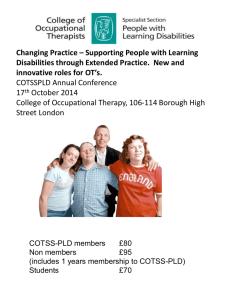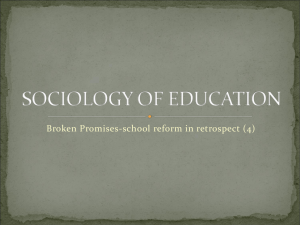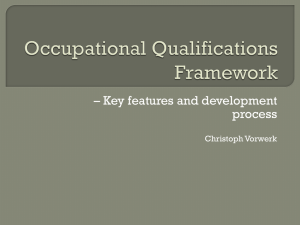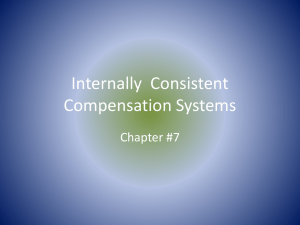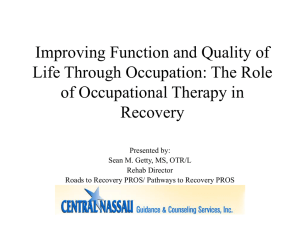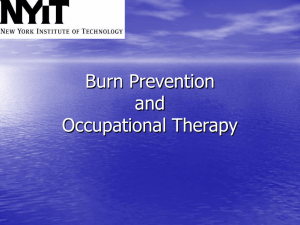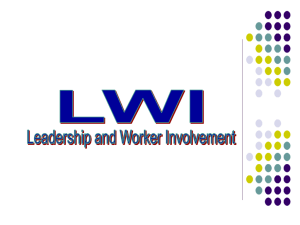The Model of Creative Ability - Vula
advertisement
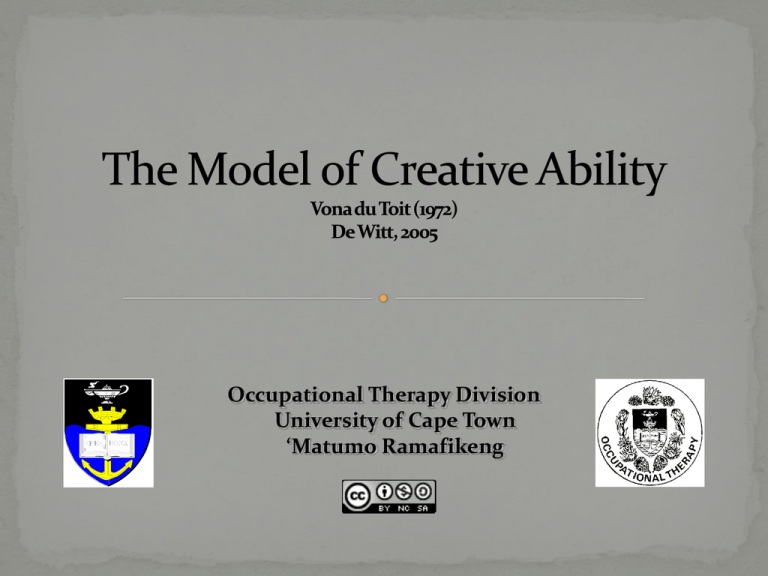
Occupational Therapy Division University of Cape Town ‘Matumo Ramafikeng Provides a framework to evaluate occupational performance in personal, social, work, recreational areas (de Witt, 2005) vs activities (duToit, 1972) OT actively engages a client in meaningful occupation to improve/maintain occupational performance and quality of life Provides assessment and treatment aspects– stratified guide to increase level of performance Brings treatment to level of individual functioning Du Toit: client’s ability to engage creatively has an effect on engagement in treatment, resolution of problems, adjustment to disability – quality of human participation influences meaning of life Buber, Piaget, Rogers (developmental psychology) Occupational development – people with psychiatric illness – stages of creativity Two research projects to justify reliability and validity Creative ability: ability to freely present oneself, without anxiety, limitations or inhibitions. Preparedness to function at maximum level of competence, free from self-consciousness Creative capacity: maximum creative potential an individual can reach under optimal circumstances – varies and is influenced by intelligence, personality, environmental, mental health and security Maximal effort: needed for growth in creative ability, exertion of creative effort at the boundary of creative ability in order to achieve growth Prerequisites for maximal effort to occur: creative response, creative participation, creative act 1. Creative response: positive attitude which towards opportunities offered, preparedness to use resources and participate despite anxiety about performance. Precedes creative participation 2. Creative participation: process of active participation all activities related to daily life, employing active vs. passive stance and embracing challenge 3. Creative Act: production of an end-product, tangible or intangible A B A: creative capacity B: current level of creative ability C: New level of creative ability D: Maximal creative effort D C Based on diagram by de Wet VOLITION is a central concept Components of volition: motivation and action Motivation: inner drive that directs action towards initiation of occupational behaviour Action: exertion of motivation into mental and physical effort which results in creation of tangible/intangible end-product Inner drive that initiates occupational behaviour Dynamic Different focus at different stages of occupational development 6 different and sequential levels aimed at developing life tasks Tone, self-differentiation, self-presentation, participation, contribution, competitive contribution Translating motivation into physical and mental effort to produce occupational behaviour and an end product (tangible or intangible) 10 different levels: sequential differences in quality of ability to form contact with others, events, materials, objects and characteristics of engagement in occupations Predestructive, destructive, incidental constructive action, explorative, experimental, imitative, original, product-centred, situation-centred, society-centred Wide range of skills and abilities within each level Need to identify where the client is at in each level Therapist-directed phase: skills and occupational behaviour characteristic of both previous and current level; may not be able to maintain functioning without support, encouragement, structure and may regress Patient-directed phase: occupational behaviour can be maintained independently and behaviour is evidently characteristic of a specific level Transitional phase: some occupational behaviour characteristics of the next level but only under optimal circumstances; overall occupational behaviour is characteristic of current level Along a continuum Few reach optimal level – limitations on creative potential, internal capacities, environment opportunities Not always consistent – spurts and comfort zones Current creative ability = aspect of creative capacity available for use in Occupational Performance Environment provides challenges and opportunities for growth, also stress that results in regression Development = dependent on fit between readiness of individual to grow creatively and the ‘just right’ challenge provided by environment Limited/disrupted by illness, disability or trauma Human development occurs in an orderly manner throughout life Steps within development process are sequential and cannot be omitted Individuals have innate drive to encounter world and master challenges Changing events and changes in internal and external environment demand adjustment and reorganization – confrontation with change represents a necessary developmental task Response to change can result in adaptation and mastery, maintenance of equilibrium or regression/dysfunction Ability to master developmental tasks is influenced by physical and psychological capacity, learned skills, life experiences, availability of resources and opportunities Successful adaptation usually leads to selfsatisfaction and societal approval Successful adaptation promotes future success in meeting challenges Purposeful use of activity enables the person to learn or relearn skills and behaviours necessary for coping with developmental demands Activities are purposeful when they meet person’s needs, interests, abilities and purpose within life and provide sufficient opportunity for growth and change (De Witt, 2005:9-10). Sequential development: growth and recovery of creative ability follows a constant sequential pattern. Level or phase cannot be omitted Motivation governs action: action is direct result of motivational aspect, the two are inseparable, levels relate in a stable and sequential manner (exception of motor capacity) Creative ability is dynamic: not static, varies with situational demands, confidence, anxiety, person’s circumstances – there is a gentle forward and backward flow between levels Provides guidelines for treatment by: o identifying treatment priorities o proposing principles for treatment appropriate to client’s level o determines expectations for performance – how and when to up/down grade Suitable for: large groups of heterogeneous clients, mental health settings, needs diverse to age, cultural group, language, diagnosis Defines how to achieve growth in occupational ability 1. Evaluate client’s current skills and abilities in occupational performance areas: work, social, constructive use of free time, personal management 2. Establish level of action 3. Draw a conclusion about level of motivation from level of action Level of creative ability is the platform from which the OT manages occupational performance and psychopathological problems Similar methods and techniques for improving components for clients on different levels, but qualitatively different occupational performance Maintain occupational performance by using meaningful and organizing activities Group one: Preparation for constructive action o tone/predestructive o Self-differentiation/destructive, incidental constructive action Group two: Behaviour and skill development for norm compliance o self -presentation/explorative o participation (passive, imitative)/experimental, imitative Group three: Behaviour and skill development for self-actualisation o participation (active, competitive)/original, productcentred o contribution/situation-centred o Competitive contribution/society centred Group one: development of functional body use, awareness of who am I, what can I do, what is my relationship to the environment. Occupational performance is limited Group two: develop necessary social, work, psychological, physical skills to live and be productive in the community Group three: develop leadership skills and novel behaviours, capable of developing new products, methods, technologies, solving problems and benefit for self becomes benefit for society De Witt, P. 2005. Creative Ability- a model for psychiatric occupational therapy. In Crouch, R. & Alers, V.(eds). Occupational Therapy in Psychiatry and Mental Health. 4th Edition. London and Philadelphia: Whurr Publishers. http://www.modelofcreativeability.com/what-is- macaig.html This work is licensed under the Creative Commons Attribution-Non CommercialShare Alike 2.5 South Africa License. To view a copy of this license, visit http://creativecommons.org/licenses/bysa/2.5/za/
